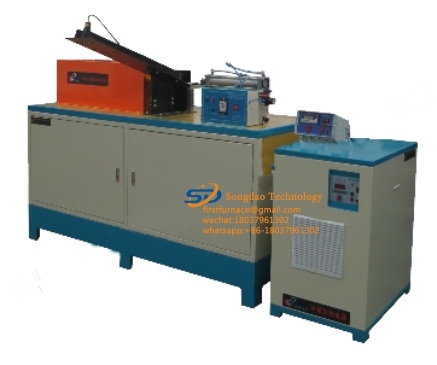- 28
- Oct
Tempering characteristics of quenched steel in induction heating furnace
Tempering characteristics of quenched steel in induction heating furnace
The structure of rapid heating hardened steel is different from traditional hardened steel, and the tempering process shows the following characteristics.
The tempering treatment of induction heating furnace is not suitable for low temperature tempering to obtain tempered martensite structure. The traditional tempering process can be carried out at high temperature (500~650°C), medium temperature (350~500°C) and low temperature (150~250°C). C) Three types of tempering treatments. The induction heating furnace is only suitable for high temperature and medium temperature tempering, not suitable for low temperature tempering. This is because when the induction heating furnace is carried out at a temperature of 150~250°C, it is difficult to realize the diathermy uniform temperature of the steel material. Due to the low heating temperature, the small temperature difference between the surface and the center, and the slow heat transfer rate, it takes a long time for diathermy to equalize the temperature, which ultimately leads to a decrease in thermal efficiency. Therefore, the tempering treatment of the induction heating furnace cannot obtain the tempered martensite structure, and the tempering temperature is above the point. At present, the tempering temperature of induction heating furnace for spring steel wire can reach as low as 400°C.
The induction heating furnace has a high tempering temperature, a large degree of overheating, and a short holding time. In order to accelerate the transformation of the structure and shorten the holding time, and realize the purpose of tempering, the tempering temperature of the induction heating furnace is higher than the tempering temperature of the traditional heating. Table 4-23 shows the comparison effect of the tempering process of induction heating furnace to increase the tempering temperature and shorten the holding time and the traditional heating and tempering process. The data in Table 4-23 indicate that in order to obtain the same 35CrM. The tempering hardness of steel, the tempering temperature of induction heating is correspondingly higher than the traditional heating and tempering temperature by 190~250°C. Increasing the tempering temperature in exchange for shortening the tempering holding time, shortened from 1800s to 40s. This shows the characteristics of rapid heat treatment in induction heating furnaces. The reason why the tempering of the induction heating furnace can be changed by temperature is mainly because temperature is the main driving force to promote the transformation of the structure. Increasing the temperature can accelerate the transformation of the structure, which is more effective than extending the holding time. Another reason is that the stability of the martensite structure of the induction heating furnace quenched steel is worse than that of the traditional quenched martensite structure, and it is easier to transform.
Table 4-23 The relationship between the hardness and tempering temperature of 35CrMo steel quenched and tempered
| Heating method | Quenching temperature/°C | Tempering insulation time
/s |
Tempering temperature ℃ | ||
| Tempering hardness (HRC) | |||||
| 40 〜45 | 35 〜40 | 30 〜35 | |||
| Induction heating furnace | 900 | 40 | 650 ℃ | 700 ℃ | 750 ℃ |
| Ordinary heating | 850 | 1800 | 400 ℃ | 480 °C | 560 ℃ |
( 3) The stability of the tempering structure of the induction heating furnace is poor. Because the induction heating furnace uses a high-temperature tempering method without heat preservation, the structure transformation is not sufficient, so its stability is poor. This tempering method cannot be used for steels that require long-term operation at high temperatures, such as low-alloy steels for power station boilers.

